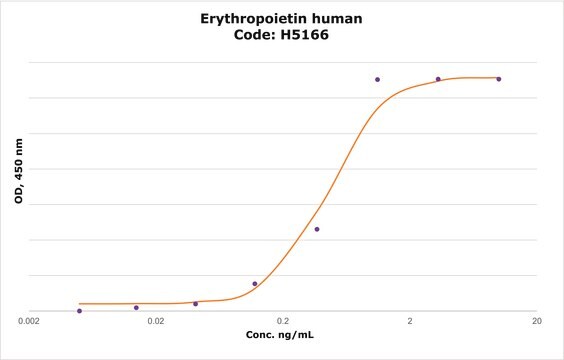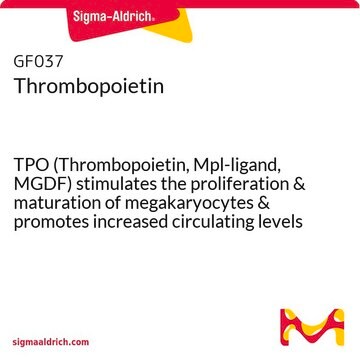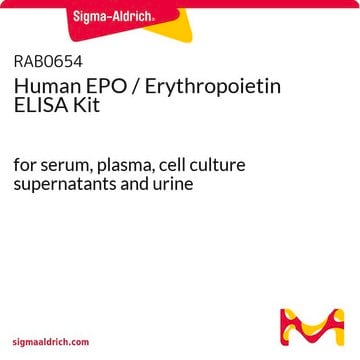SRP6158
EPO human
recombinant, expressed in HEK 293 cells, ≥95% (SDS-PAGE)
Synonym(s):
EP, EPO-alpha, Epoetin, Erythropoietin-alpha, MGC138142
Sign Into View Organizational & Contract Pricing
All Photos(1)
About This Item
Recommended Products
biological source
human
recombinant
expressed in HEK 293 cells
Assay
≥95% (SDS-PAGE)
form
lyophilized
mol wt
36 kDa (monomer, glycosylated)
packaging
pkg of 10 μg
technique(s)
cell culture | mammalian: suitable
NCBI accession no.
UniProt accession no.
shipped in
dry ice
storage temp.
−70°C
Gene Information
human ... EPO(2056)
Related Categories
General description
The gene EPO (erythropoietin) is mapped to human chromosome 7q22. It is a glycoprotein hormone. EPO is generated in fetal liver and adult kidney. However, it can also be secreted by other organs, such as the heart, brain and lungs. EPO is a member of the EPO/TPO (thrombopoietin) family and is found in the plasma.
Application
- EPO (erythropoietin) has been used as a component of the culture medium for cardiac stem cells.
- In cultured cerebellar granule cells and hippocampal neurons, it has been used to study effect of EPO on glutamate release.
- It has also been used as a component of endothelial differentiation medium.
Biochem/physiol Actions
EPO (erythropoietin) regulates red cell production by promoting erythroid differentiation and initiating hemoglobin synthesis. It interacts with EPO receptor and is responsible for the cellular responses. EPO is expressed in many cancers, including breast cancer, renal cancer, gastric cancer, hepatocellular carcinoma and central nervous system tumors. In addition, it is a hypoxia responsive cytokine and a pro-angiogenic factor. This protein also has neuroprotective activity against a variety of potential brain injuries and antiapoptotic functions in several tissue types. It can protect from brain damages due to ischemia and enhances memory as well as cognitive ability in humans suffering from vascular dementia.
Physical form
Lyophilized from a PBS solution.
Preparation Note
Centrifuge the vial prior to opening.
Reconstitution
Reconstitute in sterile PBS containing 0.1% endotoxin-free, recombinant human serum albumin.
Storage Class Code
11 - Combustible Solids
WGK
WGK 3
Flash Point(F)
Not applicable
Flash Point(C)
Not applicable
Certificates of Analysis (COA)
Search for Certificates of Analysis (COA) by entering the products Lot/Batch Number. Lot and Batch Numbers can be found on a product’s label following the words ‘Lot’ or ‘Batch’.
Already Own This Product?
Find documentation for the products that you have recently purchased in the Document Library.
Identification of human chronic myelogenous leukemia progenitor cells with hemangioblastic characteristics.
Fang B, et al.
Blood, 105, 2733-2740 (2005)
Tessa Wilkin et al.
Drug testing and analysis, 9(9), 1456-1471 (2017-03-30)
A horse's success on the racetrack is determined by genetics, training and nutrition, and their translation into physical traits such as speed, endurance and muscle strength. Advances in genetic technologies are slowly explaining the roles of specific genes in equine
PlanHab: Hypoxia counteracts the erythropoietin suppression, but seems to exaggerate the plasma volume reduction induced by 3 weeks of bed rest.
Keramidas ME, et al.
Physiological Reports, 4, e12760-e12760 (2016)
Luis Toro et al.
Kidney international, 93(5), 1131-1141 (2018-02-06)
It is accepted that osteoblasts/osteocytes are the major source for circulating fibroblast growth factor 23 (FGF23). However, erythropoietic cells of bone marrow also express FGF23. The modulation of FGF23 expression in bone marrow and potential contribution to circulating FGF23 has
Erythropoietin receptor-mediated inhibition of exocytotic glutamate release confers neuroprotection during chemical ischemia.
Kawakami M, et al.
The Journal of Biological Chemistry, 276, 39469-39475 (2001)
Our team of scientists has experience in all areas of research including Life Science, Material Science, Chemical Synthesis, Chromatography, Analytical and many others.
Contact Technical Service








